Observations¶
Ichnaea builds its database of Bluetooth, WiFi, and Cell stations based on observations of those stations. The goal is not to identify the position of the station, but to identify where the station is likely to be observed.
Depending on the observation quality, the station updating algorithm can confirm a station is active, adjust the position estimate, block it temporarily from location queries, or remove historic position data completely.
The Station Model¶
A station, regardless of type, is modeled as a circle, where the center is the weighted average position of observations, and the radius is large enough to contain historical observations.
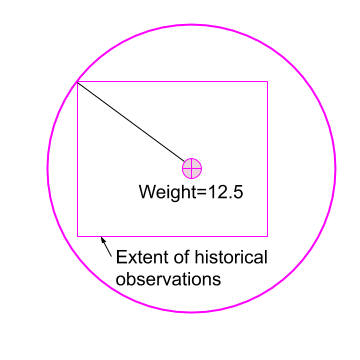
New observations are matched to the existing model. If the observations match the model type (for example, GPS submissions for a GPS-based model), then they can update the model’s position and radius.
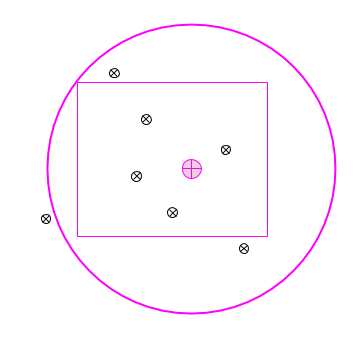
The new observations are weighted by features like accuracy, age, speed, and signal strength. Some observations have a weight of 0, and are discarded.

The station’s position is adjusted by the new observations, and the station weight is increased. Stations with many observations have a large weight, so new observations have a diminishing impact on the station position.
To complete the update, the observation bounding box is expanded, if needed, to enclose the new observations. The radius is adjusted for the new center and bounding box.
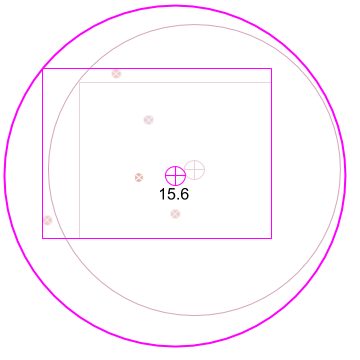
Modeling WiFi and Cell Stations¶
The station model tracks where the station is observed, and does not attempt to determine where the emitter is located.
For example, a WiFi router may physically be located inside a building, to maximize the signal for the people in the building. However, people on the sidewalk or road outside the building are more likely to observe the WiFi router at the same time they have a good GPS or other GNSS position lock. The WiFi station model will be weighted toward the outside observations, and may show a position outside of the building.
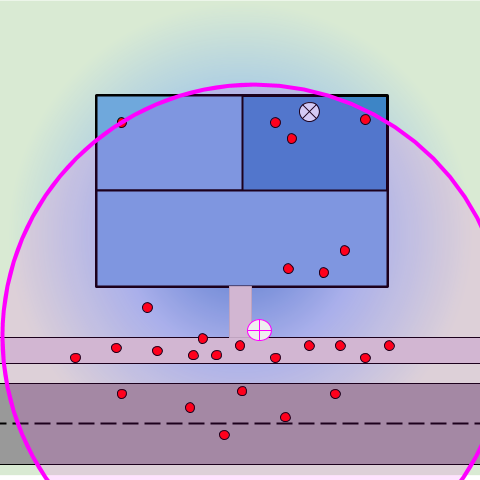
Cell signals are directional, transmitting in an arc or wedge rather than in all directions. They are often observed by phones in vehicles, such as when following directions from a map application.
In a city, the station model will encompass the service area, biased toward observations on roads. The cell emitter will often be outside of the model radius.
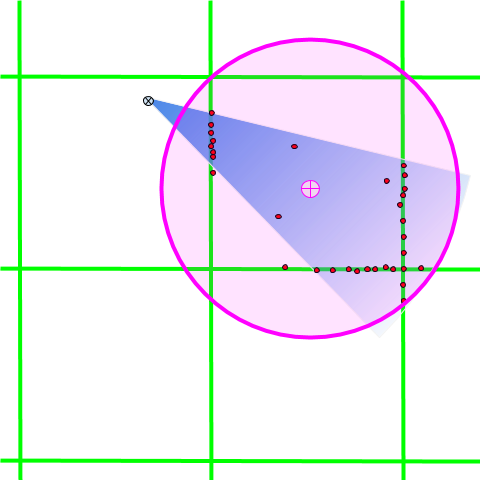
Outside of cities, a cell tower often covers a large area, and individual cell signals are broadcast in narrow wedges. The observations may be a large distance away from the emitter, along cross-country roads. The station model is often centered on these roads, and the cell signal source is well outside of the radius.
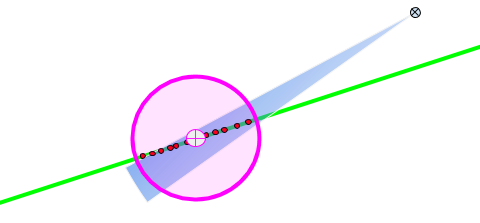
Sources and Batching¶
Observations come from two sources:
- Location queries
The device sends the detected radio sources, and Ichnaea returns a position estimate or region based on known stations and the requester’s IP address. This data is used to discover new stations, and to confirm that known stations are still active.
- Submission reports
The device sends the detected radio stations, along with a position, which is usually derived from high-precision satellite data such as GPS. These reports are used to determine the position of newly discovered stations, or to refine the position estimates of known stations.
The data flow process creates observations by
pairing the position data with each station, and then adds the observations to
update queues based on the database sharding. Cell stations are split by radio
type, and the observations are added to queues like update_cell_gsm and
update_cell_wcdma. Bluetooth and WiFi stations are split into 16 groups by
the first hexadecimal letter of the identifier, and the observations are added
to queues like update_wifi_0 and update_blue_a.
These per-shard queues are processed when a large enough batch is accumulated,
or when the queue is about to expire. Batching increases the chances that
there will be several observations for a station processed in the same chunk.
It also increases the chance that two station updating threads will try to
update the same station. This may cause timeouts or deadlocks due to lock
contention, and is tracked with the metric data.station.dberror.
A station is either based on observations from location queries (with estimated positions from Ichnaea), or from observations from submission reports (with positions from GPS or similar sources). When a station built from location queries has a valid observation from a submission report, the station is upgraded by discarding the existing position estimate and using the submitted, satellite-backed position (see the Replace transition state in the Updating Stations section below).
Observation Weight¶
Each observation is assigned a weight, to determine how much it should contribute to the station position estimate, or if it should be discarded completely. The observation weight is based on four metrics:
- Accuracy
Expected distance from the reported position to the actual position, in meters.
- Age
The time from when the radio was seen until the position was recorded, in seconds. The age can be negative for observations after the position was recorded.
- Speed
The speed of the device when the position was recorded, in meters per second.
- Signal
The strength of the radio signal, in dBm (decibel milliwatts).
The observation weight is the product of four weights:
(accuracy weight) x (age weight) x (speed weight) x (signal weight)
The first three weights range from 0.0 to 1.0. If the accuracy radius is too large (200m for WiFi), the age is too long ago (20 seconds), or the device is moving too quickly (50m/s), the weight is 0.0 and the observation is discarded. If the accuracy distance is small (10m or less), the age is very recent (2s or less), and the device is moving slowly (5m/s or less), then the weight is 1.0.
The signal weight for cell and WiFi stations is 1.0 for the average signal strength (-80 dBm for WiFi, -105 dBm to -95 dBm for different cell generations), grows exponentially for stronger signals, and drops exponentially for weaker signals. It never reaches 0.0, so signal strength does not disqualify an observation in the same way as accuracy, age, or speed. For bluetooth stations, the signal weight is always 1.0.
When accuracy, age, speed, or signal strength is unknown, the weight for that factor is 1.0.
An observation weight of 0.0 disqualifies that observation. An average observation should have a weight of 1.0. Weights are used when averaging observation positions, and when adjusting the position of an existing station. Existing stations store the sum of weights of previous observations, so that new observations have a smaller influence on position over time.
For more information, see Weight Algorithm Details.
Blocked Stations¶
Only stationary cell, WiFi, and Bluetooth stations should be considered when estimating a position for a location query. Mobile stations are identified by observations that are well outside the expected range of the station type. Ichnaea keeps track of these as blocked stations, and uses observations to keep them blocked or move them back to regular stations.
When a station is blocked, it remains blocked for 48 hours. This temporary block is used to handle a usually stationary station that is moved, such as a WiFi access point that moves to a new location.
A station’s block count is tracked, and compared to how long the station has been tracked. If a station has been blocked more times than its age in 30-day “months”, then it is considered a mobile station and remains in a long-term block. For example, if a station tracked for a year has been blocked 12 times or more, it remains in a long-term block.
Observations for blocked stations are added to the daily observation count, but are not processed to update the station. Blocked stations do not store a position estimate, but retain a region if they once had a position estimate, and can still be used for region queries.
Updating Stations¶
The observations (with non-zero weights) for a station are processed as a group, to determine how the station should be updated. If there are valid GPS-based observations, only those are used, discarding any observations based on location queries.
If an existing station is still blocked, then it remains blocked. For unblocked stations, here is the decision process for determining what the “transition state”, or update type, should be:
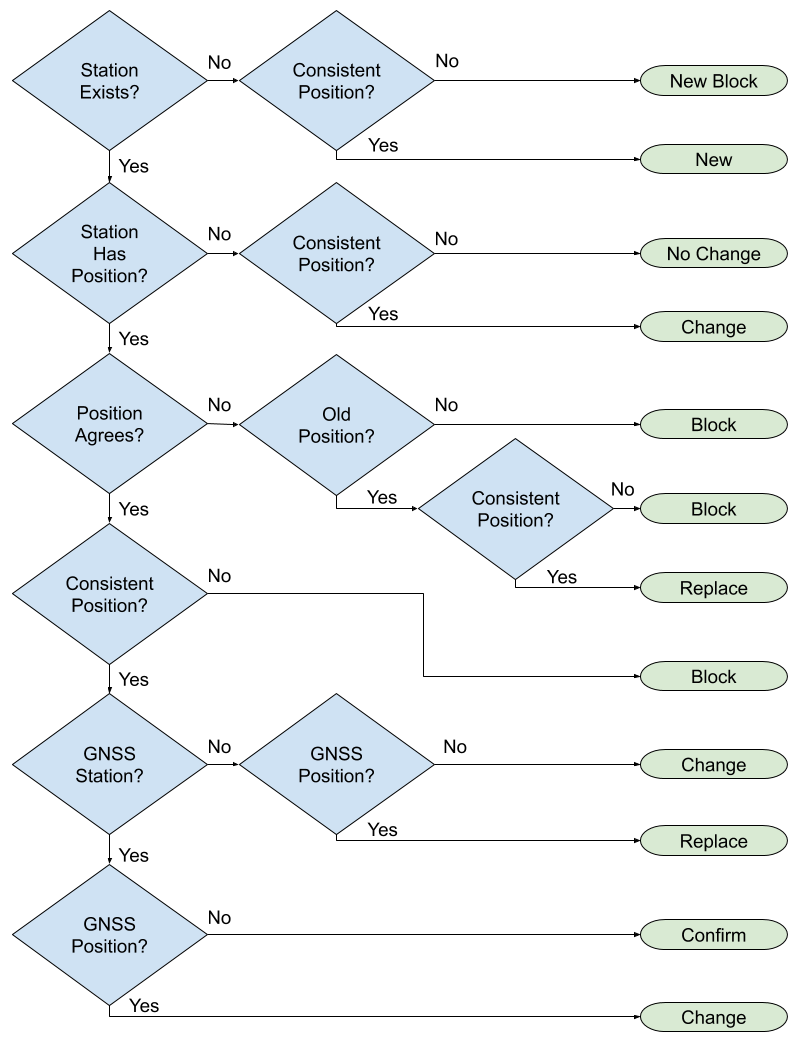
Several yes-or-no facts are used to determine the update type:
Station Exists? - Is there a record for this station in the database?
Consistent Position? - Are multiple observations close enough that they could be observing the same stationary station, or are they spread out enough that they could be observing different stations or a moving station? The “close enough” radius changes based on the type of station (100m for Bluetooth, 5km for WiFi, and 100km for cell stations).
Station Has Position? - Does the station have a position estimate in the database?
Position Agrees? - Does the station position agree with the observations, or do the observations suggest the station has moved?
Old Position? - Has the station’s position not been confirmed for over a year?
GNSS Station? - Is the station’s position based on Global Navigation Satellite System data, such as GPS?
GNSS Position? - Is the observation based on a GNSS position submission, rather than a location query?
These are used to determine a transition state:
No Change - No change is made to the station
New - A new station is added to the database.
New Block - A new blocked station is added to the database.
Change - An existing station’s position is adjusted, based on the weighted average of the current position and the observations.
Confirm - An existing station is confirmed to still be active today. Stations that were already confirmed today are unchanged.
Replace - A station’s position is replaced with the observation position
Block - A station’s position is removed, and it is blocked from being used for location queries
Related cell stations are grouped into a cell area. These can be used for location queries, when a particular cell station is unknown but others in the cell area group are known. If a cell station is created or has an updated position (all transition states but No Change or Confirm), then the cell area is added to a queue update_cellarea, and processed when enough cell areas are accumulated.
Metrics are collected based on the update type. There is a daily count of observations, and a count of newly tracked stations, both by radio type, stored in Redis. There are four statsd counters as well:
data.observation.insert- Counts all observations with a non-zero weight, including those observing a blocked stationdata.station.blocklist- Counts new stations that start blocked (New Block) and stations converted to blocked (Block)data.station.confirm- Counts existing stations confirmed to still be active (Confirm)data.station.new- Counts new stations added, either as blocked stations (New Block), or non-blocked stations (New)
Weight Algorithm Details¶
The observation weight is the product of four weights:
(accuracy weight) x (age weight) x (speed weight) x (signal weight)
The accuracy, age, and speed weights use the same algorithm, with these features:
The weight is 1.0 if the metric is small enough (at or below MIN), fully weighting the observation. If the metric is unknown, the weight is also 1.0.
The weight is 0.0 if the metric is too large (at or above MAX), rejecting the observation.
The weight drops logarithmically from 1.0 if the metric is between MIN and MAX.
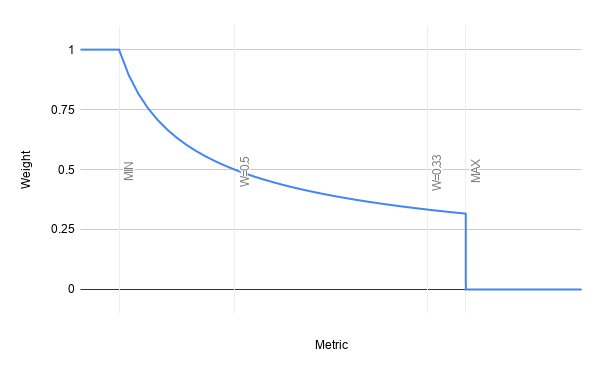
The weight curve for qualifying metrics¶
Metric |
MIN, Weight=1.0 |
Weight=0.5 |
Weight=0.33 |
MAX, Weight=0.0 |
|---|---|---|---|---|
Accuracy |
10 m |
40 m |
90 m |
100 m (Bluetooth)
200 m (WiFi)
1000 m (Cell)
|
Age |
2 s |
8 s |
18 s |
20 s |
Speed |
5 m/s |
20 m/s |
45 m/s |
50 m/s |
The signal weight algorithm varies by radio type. The signal weight is always 1.0 for Bluetooth. For WiFi and Cell radios, the weight is 1.0 for the average signal, and grows exponentially as the signal gets stronger.
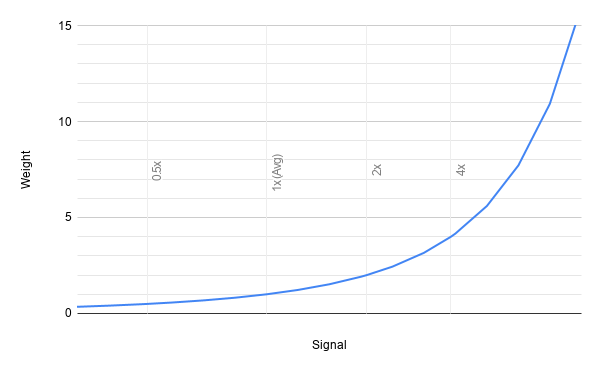
The weight curve for signal strength¶
Here are the signal strengths for interesting weights:
Radio |
Weight=0.5 |
Weight=1.0 (Avg) |
Weight=2.0 |
Weight=4.0 |
|---|---|---|---|---|
WiFi |
-98.9 dBm |
-80 dBm |
-64.1 dBm |
-50.7 dBm |
GSM |
-113.9 dBm |
-95 dBm |
-79.1 dBm |
-65.7 dBm |
WCDMA |
-118.9 dBm |
-100 dBm |
-84.1 dBm |
-70.7 dBm |
LTE |
-123.9 dBm |
-105 dBm |
-89.1 dBm |
-75.7 dBm |
If the signal strength is unknown, a signal weight of 1.0 is used.